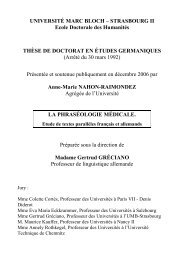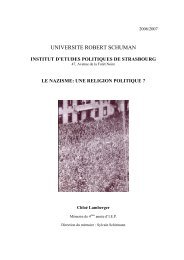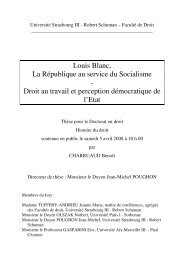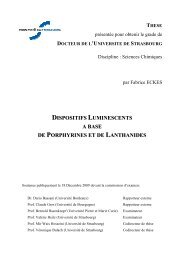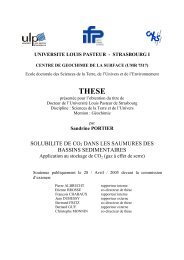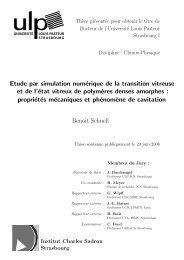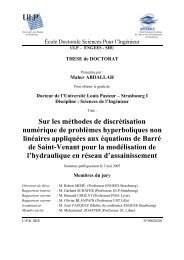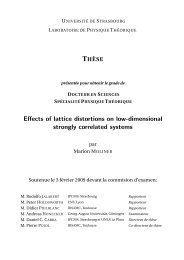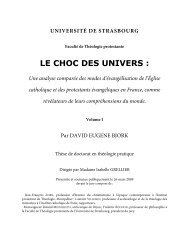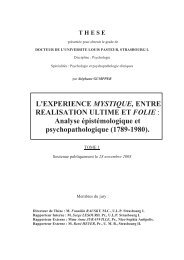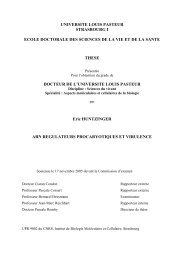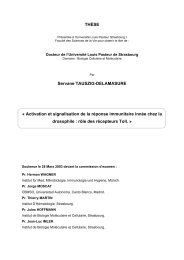1. Experimental General Considerations Chapitre III All manipulations were carried out under inert dinitrogen atmosphere, using standard Schlenk-line conditions and dried and freshly distilled solvents. The 1 H, 13 C{ 1 H}, and 31 P{ 1 H} NMR spectra were recorded unless otherwise stated on a Bruker Avance 300 instrument at 300.13, 75.47 and 121.49 MHz, respectively, using TMS, or H3PO4 (85% in D2O) as external standards with downfield shifts reported as positive. FT-IR spectra in the range of 4000-650 cm –1 were recorded on a Nicolet Nexus FT-IR spectrometer coupled with a Continuum microspectrometer, operating in diffuse reflectance. Elemental C, H, N analyses were performed by the "Service de microanalyses", Université Louis Pasteur, Strasbourg. The solid state visible spectrum of 1a was recorded on a CCD detector using a Nikon TE microscope (40 X; N.A. 0.45) and decomposed by an Acton/Princeton Instruments monochromator. The variable temperature spectra of 1a/b were recorded on a VARIAN Cary05E, equipped with a OXFORD INSTRUMENTS DN1704 cryostat. Mass spectra were recorded with a Bruker Daltonics microTOF [ESI(+) capillary voltage: 4.8 kV; nebulizer pressure: 0.2 Bar; desolvation temperature: 180 °C; desolvation gas flow rate: 30 L/h]. Magnetic measurements were performed at the Institut de Physique et Chimie des Matériaux de Strasbourg (UMR CNRS-ULP 7504) using a Quantum Design MPMS-XL SQUID magnetometer. The susceptibility measurement was performed in the 300-1.8 K temperature range with an applied field of 5 kOe. Magnetization measurements at different fields at room temperature confirm the absence of ferromagnetic impurities. Data were corrected for the sample holder and diamagnetism was estimated from Pascal constants. 2-[(diphenylphosphino)methyl]oxazoline (PNox) was prepared .[S- ] according to literature procedures 1 Anhydrous NiCl2 was prepared by dehydration of NiCl2⋅6H2O at 150°C under vacuum prior to use. Other chemicals were commercially available and used as received. 2. Synthesis 2.1 Preparation and Spectroscopic Data for 2-[(diphenylphosphino)methyl]thiazoline (PNth). 20 mL (32.0 mmol) of a 1.6 M n-BuLi solution was added dropwise to a solution of liquid 2-methyl-2-thiazoline (3.06 mL, 3.23 g, 32.0 mmol) in 100 mL of THF at –78 °C. The pale red reaction mixture was stirred for 1 h at –78 °C. Pure Me3SiCl (8.09 mL, 6.95 g, 64.0 mmol) was then added dropwise and stirring was continued at -78°C for 2h. Pure PPh2Cl (5.89 mL, 7.06 g, 32.0 mmol) was added dropwise to the colourless solution at –78 °C. The reaction mixture was allowed to reach at room temperature overnight. The volatiles were removed under reduced pressure, resulting in a yellow oily crude product which was dissolved in CH2Cl2 (50 mL). LiCl was removed 12
Chapitre III by filtration. The solvent was evaporated, yielding pure PNth as a pale yellow powder. Yield: 7.03 g, 68%. 1 H NMR (CDCl3) δ: 3.25 (t, 2H, 3 JH-H = 8.4 Hz, SCH2), 3.32 (s, 2H, PCH2), 4.14 (tt, 2H, 3 JH- H = 8.4 Hz, 5 JH-H = 0.7 Hz, NCH2), 7.32-7.48 (m, 10H, aromatic). 13 C{ 1 H} NMR (CDCl3) δ: 34.6 (d, 4 JP-C = 2.0 Hz, SCH2), 35.1 (d, 1 JP-C = 17.1 Hz, PCH2), 64.5 (s, NCH2), 128.5-137.6 (m, aromatic, PPh2), 167.7 (d, 2 JP-C = 12.2 Hz, C=N). 31 P{ 1 H} NMR (CDCl3) δ: -15.5 (s). Anal. Calcd. for C16H16NPS (285.34): C, 67.35; H, 5.65; N, 4.91. Found: C, 67.06; H, 5.94; N, 4.99. 2.2 Preparation and Spectroscopic Data for [Ni(PNth)Cl2]4 (1a). 0.73 g of solid 1b (see below) was dissolved in a minimum amount of CH2Cl2. To this, petroleum ether was quickly added (three times the volume of CH2Cl2). 1a precipitated as a pale green powder. Yield: 0.71 g, 98%. FTIR (cm -1 ) selected absorptions: 3071w, 3058w, 3038w, 3005w, 2984w, 2947w, 2932w, 2919w, 2904w, 2887w, 20870w, 2859w, 2854w, 1603vs, 1585m(sh), 1572m, 1483s, 1434s, 1397w(sh), 1382s, 1342w, 1324w, 1315w, 1277w, 1254m(sh), 1238s, 1190w, 1183w(sh), 1169w, 1159w, 1137w, 1128w, 1100s, 1093s(sh), 1071w, 1028vs, 1024vs(sh), 1004m(sh), 984w(sh), 949m, 907w, 862w, 853w, 841w, 827m(sh), 820m, 770m(sh), 764m(sh), 754m(sh), 739vs, 693vs, 690vs(sh), 672m. Anal. Calcd. for C64H64N4Cl8Ni4P4S4 (M = 1651.8): C, 46.49; H, 3.90; N, 3.39. Found: C, 46.13; H, 3.66; N, 3.40. 2.3 Preparation and Spectroscopic Data for [Ni(PNth)Cl2] (1b). A solution of PNth (0.51 g, 1.8 mmol) in methanol (10 mL) was added to a solution of NiCl2 (0.23 g, 1.8 mmol) in methanol (100 mL), resulting in a green reaction mixture. Stirring was continued for one hour at room temperature. The volatiles were removed under reduced pressure and the green solid obtained was left under vacuum for 12 h, yielding 1b as a red amorphous solid. Yield: 0.73 g, 1.75 mmol, 98%. FTIR (cm -1 ) selected absorptions: 3051w, 2986w, 2947w, 2905w, 2861w, 1603vs, 1483m, 1435vs, 1386m, 1315w, 1275w, 1240s, 1189w, 1159w, 1100s, 1029vs, 1000w, 948w, 821w, 741vs, 693vs. ESI + : [M-Cl] + 377.9779 (calcd. For [C16H16NClNiPS] + : 377.9778). Anal. Calcd. for C16H16NCl2NiPS (M = 412.9): C, 46.49; H, 3.90; N, 3.39. Found: C, 46.07; H, 3.91; N, 4.23. 2.4 Preparation and Spectroscopic Data for [Ni(PNox)Cl2]4 (2a). Complex 2b (1.20 g, 3.0 mmol, see below) was dissolved in a minimum amount of CH2Cl2. To this, petroleum ether was quickly added (three times the volume of CH2Cl2). 2a precipitated as a 13
- Page 1 and 2:
THESE Présentée à l’Universit
- Page 3 and 4:
Lisa, Mireia, Anja, Fredy, Shuanmin
- Page 5 and 6:
SOMMAIRE Composition du document et
- Page 7 and 8:
6. reference 32 Chapitre V Synthesi
- Page 9 and 10:
Composition du document et organisa
- Page 11 and 12:
Introduction La dynamique économiq
- Page 13 and 14:
Introduction La première étape co
- Page 15 and 16:
Introduction 26, 68-70 Des mécanis
- Page 17 and 18:
R R' P Ni Ph O B(Arf) R = R' = t-Bu
- Page 19 and 20:
Introduction Activés par des alkyl
- Page 21 and 22:
18 19 20 21 22 23 24 25 26 27 28 29
- Page 23 and 24:
88 89 90 91 92 93 94 95 96 97 98 99
- Page 25 and 26:
Chapitre I Nickel Complexes with Fu
- Page 27 and 28:
Abstract Chapitre I Zwitterionic N,
- Page 29 and 30:
R HN O 1 O NH R Ph Ph 3P Ni R N O 2
- Page 31 and 32:
Chapitre I As shown in Figure 1, th
- Page 33 and 34:
Chapitre I Figure 3. Views of the s
- Page 35 and 36:
Chapitre I Figure 6. View of the ar
- Page 37 and 38:
Chapitre I with the metal, 51-54 tw
- Page 39 and 40: Chapitre I these conditions, precat
- Page 41 and 42: Chapitre I The precatalyst 13-17 ha
- Page 43 and 44: Chapitre I Table 5. Catalytic Data
- Page 45 and 46: TOF mol C2H4 / mol Ni.h -1 20000 15
- Page 47 and 48: Chapitre I (s, OCH2), 81.27 (s, N
- Page 49 and 50: Chapitre I atoms introduced as fixe
- Page 51 and 52: Chapitre I (51) Tempel, D. J.; Broo
- Page 53 and 54: Abstract Chapitre II The dinuclear
- Page 55 and 56: Chapitre II Other neutral nickel co
- Page 57 and 58: OH 4 O N 4 13 OH N + 2 NiCl 2 + 2 N
- Page 59 and 60: N2-Ni1-Cl1 169.45(12) 89.35(15) N2-
- Page 61 and 62: Table 2. Selected bond distances an
- Page 63 and 64: Chapitre II solubility of 15 in chl
- Page 65 and 66: Chapitre II Table 4. Catalytic Data
- Page 67 and 68: Chapitre II Table 5. Comparative Ca
- Page 69 and 70: mass % of C4 olefins 100 90 80 70 6
- Page 71 and 72: 5. Experimental Chapitre II The 1 H
- Page 73 and 74: Chapitre II a dark green powder. Yi
- Page 75 and 76: Chapitre II 17 W. Keim, J. Mol. Cat
- Page 77 and 78: 7. Supporting information Table S1.
- Page 79 and 80: Chapitre III Unprecedented Tetranuc
- Page 81 and 82: Abstract Chapitre III Reactions of
- Page 83 and 84: Chapitre III distorted octahedral c
- Page 85 and 86: data for 2a⋅2CH2Cl2: 1.41 and for
- Page 87 and 88: Chapitre III indicate that subtle d
- Page 89: SUPPORTING INFORMATION FOR Chapitre
- Page 93 and 94: Chapitre III 4 was prepared followi
- Page 95 and 96: [S- ] 3. Evans method 2 Chapitre II
- Page 97 and 98: Chapitre III Application Constructe
- Page 99 and 100: Chapitre III [S-5] J. K. McCusker,
- Page 101 and 102: Abstract Chapitre IV The P,N-type l
- Page 103 and 104: Chapitre IV Scheme 1. Complexes wit
- Page 105 and 106: 12 PPh 2 N O N PPh 2 O N 13 P 14 15
- Page 107 and 108: Chapitre IV Although some nickel co
- Page 109 and 110: Scheme 2. Representation of the squ
- Page 111 and 112: Chapitre IV The analysis of the dif
- Page 113 and 114: Chapitre IV Table 4. Catalytic Data
- Page 115 and 116: mass % of 1-butene 100 90 80 70 60
- Page 117 and 118: Chapitre IV Table 6. Catalytic Data
- Page 119 and 120: ef Scheme 3. Proposed pathways to e
- Page 121 and 122: 4. Conclusion Chapitre IV New P,N l
- Page 123 and 124: Chapitre IV SiCH3), 30.25 (s, SiCH2
- Page 125 and 126: Chapitre IV 122.3 (s, Py), 122.5 (d
- Page 127 and 128: [Ni(µ-Cl)2{(pyridin-2-yl) methanol
- Page 129 and 130: Chapitre IV mmol of Ni complex or 1
- Page 131 and 132: 6. References (1) Ziegler, K.; Holz
- Page 133 and 134: Chapitre IV (44) Bluhm, M. E.; Foll
- Page 135 and 136: Chapitre V Synthesis and catalytic
- Page 137 and 138: Chapitre V to 16, the IR spectrum o
- Page 139 and 140: Chapitre V activated by MAO (Scheme
- Page 141 and 142:
2 OH N + PPhCl 2 NEt 3 - (HNEt 3)Cl
- Page 143 and 144:
Chapitre V Slow diffusion of heptan
- Page 145 and 146:
Chapitre V Figure 3. ORTEP view of
- Page 147 and 148:
Chapitre V tridentate ligand but wi
- Page 149 and 150:
Chapitre V spin system 1) and 3.06
- Page 151 and 152:
Chapitre V This establishes the coo
- Page 153 and 154:
TOF (mol C2H4/(mol Ni.h)) 90000 800
- Page 155 and 156:
% mass of 1-butene 80 70 60 50 40 3
- Page 157 and 158:
Chapitre V cyclic voltammograms of
- Page 159 and 160:
Chapitre V A n-BuLi solution (64.0
- Page 161 and 162:
Chapitre V IR (KBr): 1658 (vs), 147
- Page 163 and 164:
Chapitre V To a solution of (2-oxaz
- Page 165 and 166:
Chapitre V Synthesis of [Co{bis(1-(
- Page 167 and 168:
Chapitre V 30 bar working pressure
- Page 169 and 170:
6. References 1 2 3 4 5 6 7 8 9 10
- Page 171 and 172:
67 68 69 70 71 72 73 74 75 76 77 78
- Page 173 and 174:
Abstract Chapitre VI The β-keto ph
- Page 175 and 176:
Ph O 3 toluene PPh3 + Ni(COD) 2 + P
- Page 177 and 178:
Chapitre VI The synthesis of β-ket
- Page 179 and 180:
Table 1 Selected bond distances (Å
- Page 181 and 182:
Ph O toluene PR2R' + Ni(COD) 2 + C5
- Page 183 and 184:
4. Conclusion Chapitre VI The β-ke
- Page 185 and 186:
Chapitre VI and the solution was st
- Page 187 and 188:
Chapitre VI (s, p-C of OC-Ph), 131.
- Page 189 and 190:
Chapitre VI To a solution of 13.000
- Page 191 and 192:
Chapitre VI the solvents under redu
- Page 193 and 194:
Chapitre VI Crystal Structure Deter
- Page 195 and 196:
23 F. A. Hicks and M. Brookhart, Or
- Page 197 and 198:
Chapitre VII Réarrangement type Ar
- Page 199 and 200:
1. Introduction Chapitre VII Brookh
- Page 201 and 202:
N OPPh 2 OPPh 2 + NiCl2(DME) N O Ph
- Page 203 and 204:
Chapitre VII mécanisme apparenté
- Page 205 and 206:
[Ni{2,6-bis((diphenylphosphinito)me
- Page 207 and 208:
Résumé et Conclusion générale
- Page 209 and 210:
Chapitre II Résumé et conclusion
- Page 211 and 212:
Résumé et conclusion générale P
- Page 213 and 214:
Résumé et conclusion générale l
- Page 215 and 216:
Chapitre VII Résumé et conclusion



